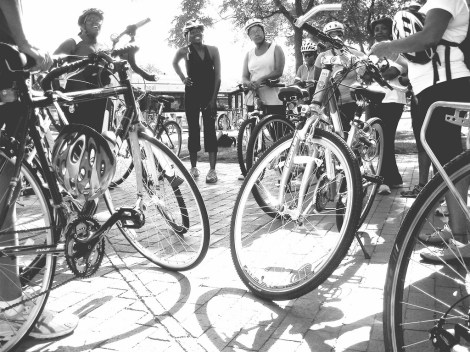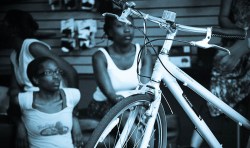Veronica Davis traces the inspiration for her all-female, African American bike club to a morning in 2011 when she pedaled past a public housing project in Southeast Washington, D.C. Co-owner of an environmental-sustainability consulting firm called Nspiregreen, Davis was taking a shortcut on her daily bike commute when she overheard a young black girl shouting to her mother, “Mommy, mommy, it’s a black lady on a bike!”
“At first, I didn’t understand why she was so excited,” says Davis. The 34-year-old civil engineer had started bike commuting about a year earlier, shortly after launching her business, partly to save money as the start-up got off the ground. “And then later, thinking about it, I realized I was probably the first cyclist riding down her street that looked like her.”
That experience led to a conversation among friends, which led to a Facebook group, Black Women Bike D.C., which exploded after a story in the Washington Post. Davis says she knew more African American women were bicycling in the District of Columbia — “I saw them” — but sensed they weren’t linked together in any type of community.
Her vision for the group was simple: to broaden the idea of who is a bicyclist to include more than just Lycra-clad weekend warriors in 20 miles-per-hour pacelines, and encourage black women and girls to ride their bikes for fun, health, wellness, and transportation. Today, more than 1,100 strong, Black Women Bike D.C. is more than just a cycling club, Davis says. It’s “a movement.”
The group organizes monthly rides as well as clinics on bike commuting, repair, and purchase, and builds community through events, a blog, and social media. It’s for mothers who want to join their children on neighborhood rides, women training for their first sprint triathlon, and everyday commuters like Davis.
Davis says D.C.’s massive bike-sharing system, along with other infrastructure efforts including green lanes and a bike lane right down the middle of Pennsylvania Avenue, have helped boost minority riding in the city. Critically, Capital Bikeshare continues to expand geographically outside its downtown base and is now up to more than 200 stations. The service recently surpassed 5 million trips.
Davis also notes, in all seriousness, that the increase in black women bicycling in the nation’s capital happens to coincide with a welcome change in African American hair fashion. “Two decades ago in D.C., black women were using and spending money on chemical straighteners in their hair and they weren’t about to sweat that out,” she says. “There’s been a move toward more natural hair styles and that’s part of what’s made this possible.”
Today, Davis says, preventing helmet hair is all about having the right satin scarf. “You can’t underestimate the importance of hair care when talking about women and bicycling,” she says with a laugh.
Black Women Bike D.C. is among a host of bicycling clubs popping up around the country aimed at getting people of color out riding. There’s the National Brotherhood of Cyclists, the Pittsburgh Mayor Taylor Cycling Club (which hosts weekly rides out of the Over The Bar bicycle café in Southside), We Bike NYC, and in Los Angeles, both the Ciudad de Luces/City of Lights and the all-female, Latina Ovarian Psyco Cycles Brigade. Others, like the three-decade-old Baltimore Metro Wheelers, have been around longer.
In fact, the percent of all trips taken by bike by African Americans grew 100 percent between 2001-2009, according to a report released this spring by the League of American Bicyclist and the Sierra Club. Similarly, the percent of all trips taken by bike by Asian Americans grew 80 percent, and by half for Latino Americans over the same time period.
Granted, whites made up a larger share of bicyclists, and the percentage of all trips taken by white bicyclists also grew — 22 percent by comparison. Still, overall, the percentage of all bicycle trips in the U.S. from those African, Asian, and Latino groups bounced from 16 to 23 percent.
Remember when the famously snarky blog Stuff White People Like listed bicycling at No. 61 a few years ago — between the Toyota Prius and “knowing what’s best for poor people”? Sorry guys, but the stereotype was already outdated.
More survey results: 86 percent of people of color have a positive view of bicyclists and 71 percent of people of color believe safer bicycling would make their community better.
Which is not to say big challenges don’t remain. While many communities are enjoying new opportunities because of the boom in bicycling, safety obstacles persist in many underserved neighborhoods. According to 2001 data from the Centers for Disease Control and Prevention, compared to white bicyclists, the fatality rate was 23 percent higher for Hispanic and 30 percent higher for African American riders.
“Bicycling and bicycling infrastructure is an economic/social justice issue,” says Carolyn Szczepanski, the League of American Bicyclists’ communication director. “It’s really a very complex issue and this report is really a first stab at starting the conversation.
“I do think that minority bicyclists have been undercounted in the past,” she adds, “but there’s also a definite trend in the number of African Americans and Latinos bicycling. We need to rethink who a bicyclist is.”
For Veronica Davis, bicycling still very much remains a pragmatic form of transportation. She doesn’t ever see herself doing century rides, for example — “I don’t enjoy riding in the country or on trails, to be honest,” she says. “I like urban biking, seeing D.C. by bike.”
She also likes the message she sends to people she passes by, like the little girl who shouted to her mom. “I used it [the public housing project] as a cut-through, and I looked like that girl,” Davis says. “And maybe that plants the seed — ‘This is something I could do.’”





